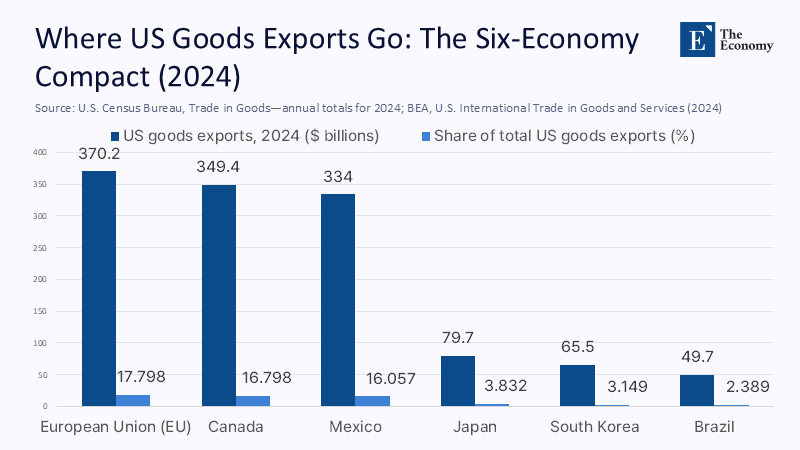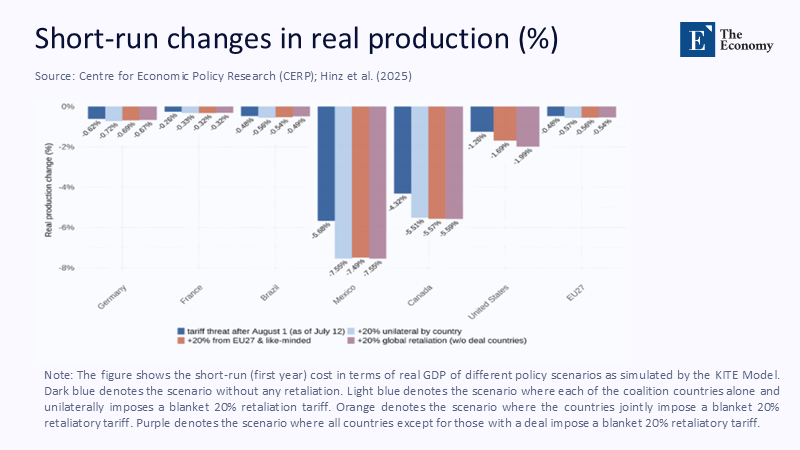Input
Changed
This article is based on ideas originally published by VoxEU – Centre for Economic Policy Research (CEPR) and has been independently rewritten and extended by The Economy editorial team. While inspired by the original analysis, the content presented here reflects a broader interpretation and additional commentary. The views expressed do not necessarily represent those of VoxEU or CEPR.
Roughly 60% of all US goods exports go to just six partners: the European Union, Canada, Mexico, Japan, South Korea, and Brazil. In 2024, the United States shipped about $2.08 trillion in goods worldwide. Of that, $370.2 billion went to the EU, $349.4 billion to Canada, $334.0 billion to Mexico, $79.7 billion to Japan, $65.5 billion to South Korea, and $49.7 billion to Brazil—amounting to approximately $1.25 trillion combined. That demand is not a talking point; it is a lever. Used together, it changes the bargaining math of any unilateral tariff campaign. With tariff deadlines, Section 232 probes, and bespoke bilateral deals now setting the tone—most recently a US–EU pact anchoring a 15% tariff and a US–Japan deal tied to a massive investment package—the question is no longer whether individual countries can negotiate down their pain. It is whether this six‑economy compact will exercise its collective market power, set conditions together, and force a predictable path back to rules‑based trade. The data say it can. The times say it must.

From Bilateral Firefighting to Coalition Deterrence
The past year has shown how a divide‑and‑conquer tariff playbook can consume diplomatic bandwidth. Washington has paired threats of across-the-board or country-specific levies with rolling, high-profile “deals” that isolate partners. The late–July US–EU arrangement lowered the threat of 30% tariffs to a 15% baseline on most EU goods, while preserving higher quotas and duties in sensitive sectors such as steel and aluminum. A week earlier, the US–Japan agreement swapped tariff relief for a colossal investment pledge. Markets exhaled; the strategic pattern hardened. Bilateral firefighting can avert a crisis headline, but it also entrenches a world where tariff coercion sets the cadence—and where each capital negotiates alone from a position of fear, not strategy. Deterrence in that world comes not from individual concessions but from credible, joint countermeasures that are too economically costly for any White House to ignore.
What would coalition deterrence look like in practice? First, the six partners publicly codify a conditional, time‑bound response to any tariff step that violates—or aims to sidestep—the spirit of reciprocal MFN treatment. Second, they commit to synchronous measures across tariffs, procurement access, investment screening, and regulatory cooperation—leveraging not just border taxes but also the flow of capital and standards. Third, they anchor the arrangement in the WTO’s legal toolkit, including coordinated dispute initiation and MPIA appeals where available, and carefully designed cross‑retaliation if disputes stall. The point is not to escalate forever; it is to deny the benefits of piecemeal capture. The United States has every interest in stable, rules‑based trade. Coalition deterrence merely restores that path by making bilateral end‑runs uneconomic.
What the Numbers Reveal: Market Power, Not Posturing
Quantitatively, the six‑economy compact is more than a political club. At roughly $1.25 trillion in US goods purchases, it accounts for nearly 60% of America’s export market. That is leverage on day one. Investment ties amplify it: US outward direct investment surpassed $6.8 trillion in 2024, with Europe and Japan among the largest hosts, and foreign direct investment into the US climbed to $5.71 trillion, led by Europe and Canada. These cross-holdings mean that exporters are not the only constituency at risk when tariff brinkmanship becomes a governing philosophy; manufacturers, investors, and workers on both sides are also exposed. A coalition that links border measures with investment certainty can, therefore, move markets and expectations at scale—without firing a shot.

The coalition’s macroeconomic weight is equally consequential. Using IMF April 2025 GDP (current prices), the EU accounts for about $20.0 trillion, Japan $4.19 trillion, Canada $2.23 trillion, Brazil $2.13 trillion, South Korea $1.79 trillion, and Mexico $1.69 trillion—a combined ~$32 trillion, or about 28% of world GDP (world ~$113.8 trillion). This is not a regional caucus; it is a globally systemic bloc whose unified signaling would instantaneously re‑price tariff risk and stabilize expectations for firms deciding where to build and source. The WTO’s own 2025 trade outlook warns that tariff uncertainty is already distorting regional flows; a coalition signal designed to reduce that uncertainty would have immediate spillovers to logistics, inventories, and pricing. Scale matters—and this coalition has it.
Designing a Joint Strategy That Works—and Holds Up in Law
A viable blueprint rests on three pillars. Pillar One: Automaticity. Partners pre‑commit to pre‑specified tariff surcharges (for example, +X percentage points on a defined list) that activate if the United States imposes unilateral hikes outside negotiated channels. The surcharges lapse automatically when measures are withdrawn or re‑channeled into WTO‑consistent settlements. Pillar Two: Scope. The response is modular—not only tariffs but also synchronized procurement preferences, tightened outbound investment screening for sensitive sectors, and temporary standards alignment to reroute supply chains among the six. Pillar Three: Legality. Members file parallel WTO disputes, route appeals through the MPIA if applicable, and are prepared to engage in cross-retaliation under Article 22 of the DSU when violations persist and adjudication is blocked. The design strikes a balance between speed and legitimacy: swift enough to deter, yet grounded enough to endure.
Skeptics will argue that such coordination invites fragmentation. That charge misreads the intent. This is not a new protectionist wall; it is a temporary collective guardrail to keep trade anchored to rules. The alternative is already visible: ad hoc bargains, tariff tranches toggled by press conference, and market whiplash. Consider July’s policy tempo alone: a looming August 1 tariff cliff; an EU deal that locks in a 15% US tariff baseline on most EU goods; a US–Japan pact that trades investment and purchases for lower auto tariffs; and renewed Section 232 probes in politically salient sectors, such as semiconductors. In that environment, a transparent, lawful, and time‑limited coalition framework lowers uncertainty, disciplines unilateral escalation, and channels disputes back toward the WTO track that all six partners publicly support.
Counting Costs Honestly—and Why a Coalition Still Pays
Every serious policy must price its costs. Broad tariff hikes behave like a consumption tax; credible estimates put a 10% universal tariff’s burden at roughly $1,500 per US household per year, even before considering second‑round effects on inflation. Revenue gains touted for universal tariffs—on the order of $225 billion in some scenarios—do not erase welfare losses when higher prices cascade through supply chains. A coalition response must therefore be targeted and reversible: surcharges calibrated to the narrowest set of tariff lines necessary to restore good‑faith bargaining, paired with certainty clauses that automatically unwind when talks resume under multilateral rules. In short, the cost of doing nothing—normalizing coercion—exceeds the carefully measured cost of credible deterrence.

What about global spillovers? The WTO’s April 2025 outlook warns that tariff uncertainty is already bifurcating trade growth across regions. The proper coalition signal—clear triggers, a narrow scope, and a fixed expiry—helps reverse that. Academic modeling is consistent with this direction: new work shows that tariff shocks are contractionary, even for the initiator, and that synchronized responses can shorten the half-life of uncertainty shocks by restoring expected rules. The coalition should publish its methodology for any response, including the tariff lines affected, the estimated price pass-through to import baskets, and the balance with targeted consumer offsets, if needed. Transparency hardens credibility—and keeps the political case disciplined.
From Blueprint to Execution: Procurement, Standards, and Supply Chains
Implementation begins where leverage is most significant, but collateral damage is minimal. First, public procurement: the six partners can expedite the mutual recognition of environmental and safety certifications, thereby opening sub-federal markets to each other, rather than relying on US contracts, where tariff pressure persists. Second, standards and conformity assessment: Synchronized standards in EVs, batteries, and medical devices can accelerate supplier reallocation without relying on blunt tariff instruments. Third, critical supply chains: align incentives for semiconductor fabs, specialty chemicals, and advanced machine tools, so that production and tooling migrate within the coalition rather than into third markets or costly duplication. As the US Section 232 chip probe nears its conclusion, an alliance that commits to upstream capacity sharing and co-investment can mitigate volatility while preserving legal contestation where appropriate.
To make this stick, the compact needs a credible timetable and institutions. A standing Trade Crisis Board—ministers plus central bank deputies—can convene on 72 hours’ notice to activate or suspend measures. A technical secretariat should publish quarterly scorecards: tariff lines hit, trade diverted, price pass‑through estimates, and the status of WTO proceedings. When bilateral deals materialize (as with the recent US–Japan and US–EU understandings), the board should assess whether they reinforce or undermine coalition aims. If a bilateral agreement is consistent with the rules and reduces overall tariff uncertainty, coalition measures ratchet down in lockstep; if not, the automaticity clause takes effect. The objective is discipline: reward de‑escalation, penalize divide‑and‑conquer.
Why Past Regional Attempts Faltered—and Why a Bigger Bloc Can Succeed
East Asia’s efforts at trilateralism illustrate the challenge. In recent months, China, Japan, and South Korea have edged toward tactical economic cooperation under pressure from renewed US tariff activism—yet unresolved historical grievances and security alignments have limited how far coordination can progress. The lesson is not that regionalism fails; it is that politically mismatched trilaterals struggle to sustain deterrence against a large external player wielding tariffs as a domestic policy instrument. A broader six-economy compact, anchored in like-mindedness on market rules—encompassing the EU, Canada, Mexico, Brazil, Japan, and South Korea—faces fewer structural impediments. It gathers economies with deep WTO engagement (many are MPIA members), multiple interlocking trade agreements, and a shared interest in keeping the trading system from becoming a sequence of press‑driven bargaining sprints.
Across the Atlantic and the Americas, partial attempts already exist. The EU and Canada have recently reaffirmed their partnership, explicitly linking trade to rule-of-law commitments and multilateralism. Mexico and Brazil, squeezed by tariff uncertainty, announced moves to strengthen bilateral trade in spring 2025. Yet without alignment with the EU and key Asian exporters, such pairings have limited deterrent force—and face the risk of being peeled off by new bilateral offers. By sitting together, the six economies transform isolated hedges into a credible front. They also shield the most exposed sectors—autos, steel, agri‑food, and electronics—from permanent uncertainty by setting a collective price for coercion. That is the only price Washington will consistently calculate.
Anticipating Pushback—and Answering It
One critique argues that a coordinated response will inflame Washington and trigger even higher tariffs. The evidence suggests restraint is already dwindling: Brazil was recently singled out for 50% tariffs tied to domestic politics, and the US–EU and US–Japan deals still embed elevated baselines. Deterrence requires a predictable ceiling. A coalition that pre‑commits to narrow, lawful, and reversible countermeasures offers a ceiling—while preserving an off‑ramp when negotiations return to rules. That structure reduces the expected payoff from divide‑and‑conquer and restores incentives to deal in good faith.
A second critique claims that households in the coalition will bear the brunt of retaliation. That is a serious concern—hence the emphasis on targeted lines and short windows, coupled with consumer offsets where necessary. The welfare calculus is dynamic: by reducing the duration of uncertainty and preventing successive bilateral agreements that ratchet up tariffs across sectors, coalition action can lower medium-term costs relative to a world of rolling brinkmanship. The WTO’s 2025 forecast documents how tariff shocks divert trade and suppress volumes; blunting that instability is itself a consumer benefit. Paired with sector‑specific cooperation on chips and clean energy, the compact would narrow the incidence of countermeasures while quickening a return to predictable rules.
The Play for Educators, Administrators, and Policymakers
For educators, the moment calls for teaching trade policy as a strategic interaction rather than a single‑country optimization problem. Curricula should integrate coalition formation, cross‑retaliation law, and standards diplomacy alongside comparative advantage. Students should model outcomes under automatic, joint responses versus uncoordinated bilateral responses—then test welfare impacts using transparent pass-through assumptions rooted in recent household-level estimates. That is where the next generation of policy designers will be forged.
For administrators, procurement and standards are the fastest levers to pull without punishing consumers. Universities, hospitals, and public agencies can adopt mutual recognition with coalition suppliers in priority categories to mitigate tariff-driven shortages or supply chain disruptions. Meanwhile, standards bodies should accelerate cross-recognition in fast-moving fields—such as battery safety and cybersecurity for medical devices—to prevent innovation cycles from being stalled by tariff noise. For policymakers, the ask is straightforward: codify the compact, publish the triggers, and bind the timeline. Then, when the next tariff letter lands, the response will be automatic, measured, and reversible—and the conversation can move back to rules.
The 60% Solution
Return to the statistic that opened this column: nearly three‑fifths of US goods exports depend on six partners that already share deep trade, investment, and legal ties. Fragmented, they will continue to cut side deals to survive the next 90-day scare. Combined, they can end the tariff carousel by making unilateral escalation predictably unprofitable and the path back to multilateralism predictably attractive. The plan is not to punish; it is to discipline—with automaticity, narrow scope, and a bright‑line sunset that lifts when rules are honored. This is a typical game of coalition formation facing a divide‑and‑conquer strategy. The counter is equally typical: team up and stand together against the tide. The six-economy compact is ready-made; the legal tools exist, and the stakes—consumer welfare, investment certainty, and a rules-based order—are immediate. Convert leverage into lawful discipline, and the world’s trading system will remember how to breathe.
The original article was authored by Julian Hinz, a Professor of International Economics at Bielefeld University, along with four co-authors. The English version, titled "An alliance for open trade: How to counter Trump's tariffs," was published by CEPR on VoxEU.
References
Aceris Law. (2025). WTO Multi‑Party Interim Appeal Arbitration (MPIA): Shrinking the Void? Retrieved July 2025.
AP News. (2025, April). Mexico and Brazil agree to strengthen trade ties in the wake of Trump tariff turmoil.
AP News. (2025, July). Trump tariffs goods from Brazil at 50%…
Bergin, P., & Corsetti, G. (2023). The Optimal Monetary Policy Response to Tariffs (NBER Working Paper No. 33560).
Bown, C. P., & PIIE. (2024). Why Trump’s Tariff Proposals Would Harm Working Americans (Policy Brief 24‑1).
European Commission / Eurostat. (2025). Trade in goods with the United States in 2024.
EUnews. (2025, June 24). EU and Canada, partners once betrayed by Trump…
Financial Times. (2025, July 28). How the EU succumbed to Trump’s tariff steamroller.
Hinrich Foundation. (2025). The WTO stands at a “whatever it takes” moment.
IMF. (2025). World Economic Outlook, April 2025 (database entries for EU, Japan, Canada, Brazil, Korea, Mexico; World totals).
Peterson Institute for International Economics. (2024). Can Trump replace income taxes with tariffs? (Realtime Economics).
Reuters. (2025, July 23). Trump strikes tariff deal with Japan, auto stocks surge.
Reuters. (2025, July 27–28). US to release result of probe into chip imports in two weeks; US and EU clinch deal with 15% tariff on most EU exports; Investors eye possible US–Europe trade deal as deadline looms.
US BEA. (2025). US International Trade in Goods and Services, December and Annual 2024; Direct Investment by Country and Industry, 2024.
US Census Bureau. (2025). Top Trading Partners — December 2024; Trade in Goods with European Union (2024).
U.S. USTR. (2025). Country pages: European Union; Mexico; Japan; Korea; Brazil.
WTO. (2025, April 16). Temporary tariff pause mitigates trade contraction, but strong regional divergences remain (Global Trade Outlook).
WTO. (n.d.). Dispute settlement — Appellate Body; Stages in a typical WTO dispute settlement case (countermeasures).
East Asia Forum. (2025, June 4). Trump’s return drives closer cooperation in East Asia.






















Comment